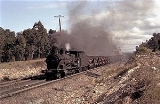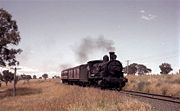
New South Wales D50 class locomotive
Encyclopedia
The D50 class is a class of 2-8-0
steam locomotive
built for and operated by the New South Wales Government Railways
of Australia
.
delivered the first five of the now ‘Australian Consolidation’ type heavy duty goods locomotive, these being the forerunners of the numerically largest class on the system, finally totalling 280 representatives. in the operation of goods trains they followed up the successful record of their passenger counterparts, the P(6)-class, being most effective on the steep gradients and sharp curves of the main lines over mountainous sections. Their second and third coupled wheel tyres were flangeless to reduce curve friction.
The five builders who contributed to the numbers were:-
Beyer, Peacock and Company
: 151
Dübs and Company
: 5
Neilson and Company
: 10
North British Locomotive Company
: 84
Clyde Engineering Company Limited
: 30
During the First World War, an additional 10 locomotives of this class were under construction at the North British Locomotive Company, but these were not delivered to Australia, being taken over by the British War Office for the Royal Engineers
Railway Operating Division
. After the war, they were offered back to the N.S.W.G.R.
at higher than new prices and in a badly worn condition. They were declined and were subsequently acquired by a Belgian railway and, following rebuilding, assigned to work coal trains along the Meuse Valley
.
The Commonwealth Railways
also chose this design to be their first goods locomotive class, the K-class, for the Trans-Australian Railway
.
 Many of the D50-class received a turret type tender in later years which provided better visibility when operating in reverse.
Many of the D50-class received a turret type tender in later years which provided better visibility when operating in reverse.
During their many years of service, almost to the end of the steam era, there were few lines over which they were not permitted to work. It was often the practice at holiday times to press them into service hauling the extra excursion trains operating to Gosford
and Wollongong
where their restricted speed had little effect on the schedules. These locomotives, together with the later D53-class and the D55-class, became known as the Standard Goods engines.
In the later years, the saturated, i.e. non-superheated
, members of the class were normally restricted to working coal trains, commonly made up of 4-wheel hopper wagons not fitted with continuous air-brakes, in the Hunter Valley and shunting duties in the larger marshalling yards throughout the system.
, has been preserved by the New South Wales Rail Transport Museum
and is presently stored at Broadmeadow Roundhouse. 5069 and 5132 are preserved by the Dorrigo Steam Railway and Museum
whilst 5112 is in the care of Bathurst Regional Council
as a memorial to former Australian Prime Minister, Ben Chifley
. This loco was statically restored by the Hunter Valley Rail Trust in Branxton, and is now back in Bathurst.
5132, the only preserved superheated 50, is at the DSR&M.
2-8-0
Under the Whyte notation for the classification of steam locomotives, 2-8-0 represents the wheel arrangement of two leading wheels on one axle , eight powered and coupled driving wheels on four axles, and no trailing wheels...
steam locomotive
Steam locomotive
A steam locomotive is a railway locomotive that produces its power through a steam engine. These locomotives are fueled by burning some combustible material, usually coal, wood or oil, to produce steam in a boiler, which drives the steam engine...
built for and operated by the New South Wales Government Railways
New South Wales Government Railways
The New South Wales Government Railways was the government department that operated the New South Wales Government's railways until the establishment of the Public Transport Commission in 1972. Although later known officially as the Department of Railways, New South Wales, it was still generally...
of Australia
Australia
Australia , officially the Commonwealth of Australia, is a country in the Southern Hemisphere comprising the mainland of the Australian continent, the island of Tasmania, and numerous smaller islands in the Indian and Pacific Oceans. It is the world's sixth-largest country by total area...
.
History
In 1896, Beyer, Peacock and CompanyBeyer, Peacock and Company
Beyer, Peacock and Company was an English railway Locomotive manufacturer with a factory in Gorton, Manchester. Founded by Charles Beyer and Richard Peacock, it traded from 1854 until 1966...
delivered the first five of the now ‘Australian Consolidation’ type heavy duty goods locomotive, these being the forerunners of the numerically largest class on the system, finally totalling 280 representatives. in the operation of goods trains they followed up the successful record of their passenger counterparts, the P(6)-class, being most effective on the steep gradients and sharp curves of the main lines over mountainous sections. Their second and third coupled wheel tyres were flangeless to reduce curve friction.
The five builders who contributed to the numbers were:-
Beyer, Peacock and Company
Beyer, Peacock and Company
Beyer, Peacock and Company was an English railway Locomotive manufacturer with a factory in Gorton, Manchester. Founded by Charles Beyer and Richard Peacock, it traded from 1854 until 1966...
: 151
Dübs and Company
Dûbs and Company
Dübs & Co. was a locomotive works in Glasgow, Scotland, founded by Henry Dübs in 1863 and based at the Queens Park Works in Polmadie. In 1903 it became part of the North British Locomotive Company.-Preserved locomotives:...
: 5
Neilson and Company
Neilson and Company
Neilson and Company was a locomotive manufacturer in Glasgow, Scotland.The company was started in 1836 at McAlpine Street by Walter Neilson and James Mitchell to manufacture marine and stationary engines...
: 10
North British Locomotive Company
North British Locomotive Company
The North British Locomotive Company was created in 1903 through the merger of three Glasgow locomotive manufacturing companies; Sharp Stewart and Company , Neilson, Reid and Company and Dübs and Company , creating the largest locomotive manufacturing company in Europe.Its main factories were...
: 84
Clyde Engineering Company Limited
Clyde Engineering
Clyde Engineering was the name of part of the business now known as Downer EDI Rail. Clyde Engineering were involved in the construction of railway locomotives and rolling stock, as well as larger scale engineering projects on behalf of the governments of Australia...
: 30
During the First World War, an additional 10 locomotives of this class were under construction at the North British Locomotive Company, but these were not delivered to Australia, being taken over by the British War Office for the Royal Engineers
Royal Engineers
The Corps of Royal Engineers, usually just called the Royal Engineers , and commonly known as the Sappers, is one of the corps of the British Army....
Railway Operating Division
Railway Operating Division
The Railway Operating Division was a division of the Royal Engineers formed in 1915 to operate railways in the many theatres of the First World War...
. After the war, they were offered back to the N.S.W.G.R.
New South Wales Government Railways
The New South Wales Government Railways was the government department that operated the New South Wales Government's railways until the establishment of the Public Transport Commission in 1972. Although later known officially as the Department of Railways, New South Wales, it was still generally...
at higher than new prices and in a badly worn condition. They were declined and were subsequently acquired by a Belgian railway and, following rebuilding, assigned to work coal trains along the Meuse Valley
Meuse River
The Maas or Meuse is a major European river, rising in France and flowing through Belgium and the Netherlands before draining into the North Sea...
.
The Commonwealth Railways
Commonwealth Railways
The Commonwealth Railways were established in 1912, as part of a government department, currently called the Department of Infrastructure, Transport, Regional Development and Local Government, by the Government of Australia to construct the missing link in the east-west transcontinental railway and...
also chose this design to be their first goods locomotive class, the K-class, for the Trans-Australian Railway
Trans-Australian Railway
The Trans-Australian Railway crosses the Nullarbor Plain of Australia from Port Augusta in South Australia to Kalgoorlie in Western Australia...
.

During their many years of service, almost to the end of the steam era, there were few lines over which they were not permitted to work. It was often the practice at holiday times to press them into service hauling the extra excursion trains operating to Gosford
Gosford, New South Wales
Gosford is a city located on the Central Coast of New South Wales, Australia, approximately 76 km north of the Sydney central business district...
and Wollongong
Wollongong, New South Wales
Wollongong is a seaside city located in the Illawarra region of New South Wales, Australia. It lies on the narrow coastal strip between the Illawarra Escarpment and the Pacific Ocean, 82 kilometres south of Sydney...
where their restricted speed had little effect on the schedules. These locomotives, together with the later D53-class and the D55-class, became known as the Standard Goods engines.
In the later years, the saturated, i.e. non-superheated
Superheated steam
Superheated steam is steam at a temperature higher than water's boiling point. If saturated steam is heated at constant pressure, its temperature will also remain constant as the steam quality increases towards 100% Dry Saturated Steam. Continued heat input will then generate superheated steam...
, members of the class were normally restricted to working coal trains, commonly made up of 4-wheel hopper wagons not fitted with continuous air-brakes, in the Hunter Valley and shunting duties in the larger marshalling yards throughout the system.
Preserved
5096, the first locomotive to be built by Clyde Engineering Company at GranvilleGranville, New South Wales
Granville, is a suburb in western Sydney, Australia. Granville is located west of the Sydney central business district, in the local government area of the City of Parramatta. A small part in the north-west is located in the Local Government Area of the City of Holroyd.South Granville is a...
, has been preserved by the New South Wales Rail Transport Museum
New South Wales Rail Transport Museum
The New South Wales Rail Transport Museum located in Thirlmere, New South Wales south-west of Sydney, is a museum dedicated to displaying former locomotives, carriages and goods wagons from the New South Wales Government Railways as well as private operations in NSW. The collection features steam,...
and is presently stored at Broadmeadow Roundhouse. 5069 and 5132 are preserved by the Dorrigo Steam Railway and Museum
Dorrigo Steam Railway and Museum
The Dorrigo Steam Railway and Museum in Dorrigo, New South Wales, Australia is a large, privately owned collection of preserved railway vehicles and equipment from the railways of New South Wales, covering both Government and private railways...
whilst 5112 is in the care of Bathurst Regional Council
Bathurst Regional Council
Bathurst Regional Council administers the Bathurst Region Local Government Area in New South Wales, Australia. It is approximately 200 km west of Sydney and has a population of 37,001 . It is on the Great Western Highway, Mid-Western Highway, Mitchell Highway and the Main Western railway...
as a memorial to former Australian Prime Minister, Ben Chifley
Ben Chifley
Joseph Benedict Chifley , Australian politician, was the 16th Prime Minister of Australia. He took over the Australian Labor Party leadership and Prime Ministership after the death of John Curtin in 1945, and went on to retain government at the 1946 election, before being defeated at the 1949...
. This loco was statically restored by the Hunter Valley Rail Trust in Branxton, and is now back in Bathurst.
5132, the only preserved superheated 50, is at the DSR&M.

